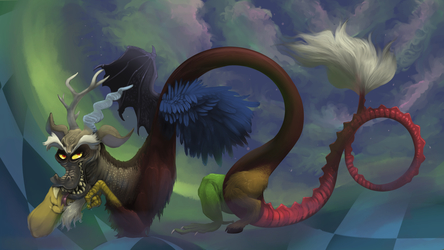Sign In
Close10 Tips for Artists to Avoid Burnout by jonas

10 Tips for Artists to Avoid Burnout
Disclaimer: I am not a certified professional anything. All I have is 20 years of advice I've read and been told about how to keep from getting burned out on art, and from that advice, I've condensed and summarized here what has worked for me. Take what I say with a big fat grain of salt. What works for you might be different, but sometimes it helps to have starting points for ideas.
Maintain a decent diet
Yeah, I know, first one right out the gate is the advice some parental figure probably threw at you years ago. It doesn't have to be all tofu and wheatgrass, but one thing to remember about being an artist is that doing art isn't always a simple activity. If you're fingerpainting, yeah, it's easy. However, if you're simultaneously orchestrating memory, coordination and spatial organization to draw complex perspective or interacting muscle groups or whatever, then it's going to demand a greater share of the resources in your brain. That lump of grey matter in your noggin requires specific neurotransmitters to be present in specific ranges for it to work, and there are a number of foods out there that happen to be rich in the precursor chemicals your body can use to synthesize those neurotransmitters. You might be fried out on whatever pic you're working on because you're literally running on empty, rather than having any kind of nebulous artistic inner-child crisis, and you might not even be able to recognize it for what it is.Allow yourself a warmup period
Understand that every single day you have to restart the machinery, and that even if you're a seasoned professional, your first few doodles of the day might look like shit. It just happens sometimes, just like you can't give a speech when you first get out of bed. A frequent impulse when you look at the first bits of chickenscratch of the day is to put down the pencil (or stylus) and do something else. When you feel that impulse, ignore it and try drawing some more. Fill your page up with stuff no matter how bad it looks to your eye. See if you can make your way over that hump and get to a point where you like what you're drawing. It might make a bigger difference than you think.Draw for fun
No, seriously, do not forget to do this. Yes, you're on deadline. Yes, your bank balance is precarious. Yes, rent is due in three days. Trust me, I've been there so many times I've lost track. However, this does not mean you can't take a few minutes out of every hourlong work cycle to draw something dumb, or silly, or sexy, or whatever. In fact, you need it. If you're under the gun, chances are you're building up a lot of anxiety, and if you're working on commissions, they may not necessarily be subject matter you specifically want to draw. (If you're lucky, maybe all your commissions are stuff you want to draw! Congrats! But it doesn't always work out that way...) In any event, your brain needs a break sometimes.Take in diverse sources
Younger artists have a tendency to crib existing styles, and there's nothing wrong with this; it's just a systematic proxy method of approaching the greater issue of learning to draw from scratch. Many of us, at some point, were learning from some of the most popular bookshelf sources, such as how-to-draw books for Disney characters or anime characters, or even (ugh) Christopher Hart books. Again, nothing wrong with this. However, there is an unprecedented volume in this day and age of searchable, instantly accessible, free art and art-related study material on the internet. Beyond that, university libraries have scores of resources on the last few millennia of art from around the world. You may not think it applies to you because your style of caricature is incompatible with dadaism, for example, and that's fine. But underneath the particular (and sometimes bizarre and awkward) examples of every art movement are elements you can use, like brush styles, modes of color, and so on. The basics of every art movement are fundamental visual algorithms applied towards processing human perception and thought into artistic reproductions, and those can transcend particular examples. You never know what might inspire you, and when it does, your art will begin to reflect it, consciously or otherwise.Don't stop for more than a few weeks
You will go through cycles, just like anyone does, and when you feel like you've hit bottom, it's unreasonable to expect youtself to be the art machine you are when you are at the peak of the cycle. However, don't stop. Try to do at least one little doodle a day, even if it's just a napkin doodle. Even if it looks wretched, even if it's uninspired, even if you crumple it up immediately afterwards, it's something. It's still a tiny, vital part of your everyday life, however small. It's easy to backburner the act of making art, since it's not a survival skill, and we are frequently called upon in our modern lives to deal with much more immediate, frustrating life stuff, sometimes even tragedy and loss. However, whatever urge that started you drawing in the first place was strong enough and important enough to encourage you to dive into a new medium and start swimming. If nothing else, art can be a part of the backbone of your identity. And the bottom line is this: if you stop drawing for too long, the inertia you gather will make restarting after a month or longer much, much harder than you'd expect.Don't be afraid to ask for space
Don't isolate yourself, of course, but some types of art require a fundamentally introverted approach. There are certainly long-celebrated forms of art that are extroverted -- storytelling, song, dancing, and the stage for example -- but art forms like painting or design or illustration often demand a degree of introspection. You're taking in or recalling sensory information, applying thoughts and/or emotions, and the only outwardly visible aspect of this is the finished product itself. Some artists can juggle social interaction with simultaneous art creation, some can't. Chances are you already know what your threshold is in this regard. Don't get angry at people because they're intruding into the space or time you've set aside for making art, but also don't be afraid to assert yourself. Sometimes you just need to spell out to people (even close friends or significant others) that this is how you do it, this is where you do it, and this is when you do it, and if you don't get that allocation, it won't get done. If they respect you, they'll listen. Just remember to come out of there when you're done and spend a little time with them.Draw from life and the outdoors once in a while
Life drawing is vital because it allows for analysis of poses, forms and specifics of the human body that static poses or idealized illustrations cannot. People have specific features and move in specific ways, and breaking those down and understanding them is the key to achieving that elusive quality of liveliness in an image. The most human aspects of a person aren't really the anatomical features we all have in common; it's the little things, the scars, the tics, the wrinkles and postures and unique gestures and tiny genetic quirks. If you can reproduce those, you'll be reproducing a person rather than merely a human form. If you can't draw from life, look up life drawing websites like posemaniacs.com. Secondly, draw outdoors. Yes, for some of you this may be sharply outside of your comfort zone, but there are several advantages to drawing outside. One, it lets you sketch natural growth/damage patterns of things like trees and rocks. Two, no matter how comfortable your usual art space can be, sometimes getting out of it is the best way to break yourself out of the rut of the familiar. Three, nobody will get on your case for drawing in public. Who knows? Maybe you'll even make a friend.Figure out precisely what is helping and what is hindering
Arrange your environment to bolster your creativity. If you're willing to allocate a space and time for making your art, you should optimize that space (within your budget). With every artist, there are sets of sensory inputs that help them focus, and others that hinder that focus. Many of these are common-sense factors that would help/hinder anyone's focus, not just that of an artist specifically, but every individual has specific sensory cues that will encourage them, often subconsciously. Think carefully about this. Does a cluttered studio make it harder to focus on the canvas? Does fluorescent light give you a headache? What about ambient noise? White noise? Maybe a certain kind of music? What scents do you potentially associate with a calm environment? It doesn't have to be a shrine with incense and patchouli, but it shouldn't be a cold, sterile office either. Find a medium that works for you.Change into a 'work outfit'
Even if you're unemployed and nobody sees you when you work, don't just start working as soon as you're up in whatever you're wearing (or not wearing). Shower, eat, get dressed -- it doesn't have to be a suit and tie, but at least something clean. Why go through the motions, you might ask? For the same reason you might need space or a specific environment to work. You're kind of tricking your brain, making it think you're doing a conventional job -- because you are. The only difference is your surroundings, which just happen to be the place you live in. However, this in and of itself can be a deterrent, because in an office job you can't just plunk down on your bed for a break or a nap, but here you can. YOU have to be the office, because like it or not, this is your income.Give yourself little rewards
It doesn't matter if they're idiosyncratic or seem juvenile; your brain still needs them. In this job there are no co-workers or bosses, and in some ways that's good. In other ways, however, it's not. If you've ever been in a job where the bosses or co-workers are nice, you'll understand where I'm coming from. Sometimes you'll get little gifts, parties, even just a day where the boss buys everyone lunch, and those are good, because they reinforce a sense of humanity in a job that might otherwise seem mechanical and cold. When you're all alone and working on commissions, you have to invent the perks and reward yourself. You shouldn't give yourself pats on the back for every single commission you finish -- every time you stop to admire the view, it means you'll take that much longer to reach the summit. However, if you've just finished a big wave of commissions, take 10% of the earnings and go buy yourself something nice. Or even just something useful, like a new set of watercolors. Whatever it is, as long as it doesn't break your bank, indulge a little. It'll make you feel a lot better in the long run**.**
A little something I've been working on. I sometimes see young artists in the fandom really just brutally hitting the wall, and I thought I'd offer a few suggestions about how to avoid that. I'm not a professional, so please take what I say with a grain of salt.
Submission Information
- Views:
- 1527
- Comments:
- 5
- Favorites:
- 64
- Rating:
- General
- Category:
- Literary / Other









Link
LostPlatformer
Informitive and clear. I myself find it very hard to motivate myself to continue to sketch, this "10 Tips to avoid artist burnout" has gotten me thinking where I've gone wrong and how I should improve. I mainly believe it's more deadlines as I'm studying at a University, with everything I sketch going towards 3D models and concepts for a certain thing, it's difficalt to innovate beyond what's expected.
Enough about where I think I'm going wrong, this account is a clear and a thoroughly explained guide that I'll keep a close eye on whenever I feel burned out again... Metaphorically speaking.